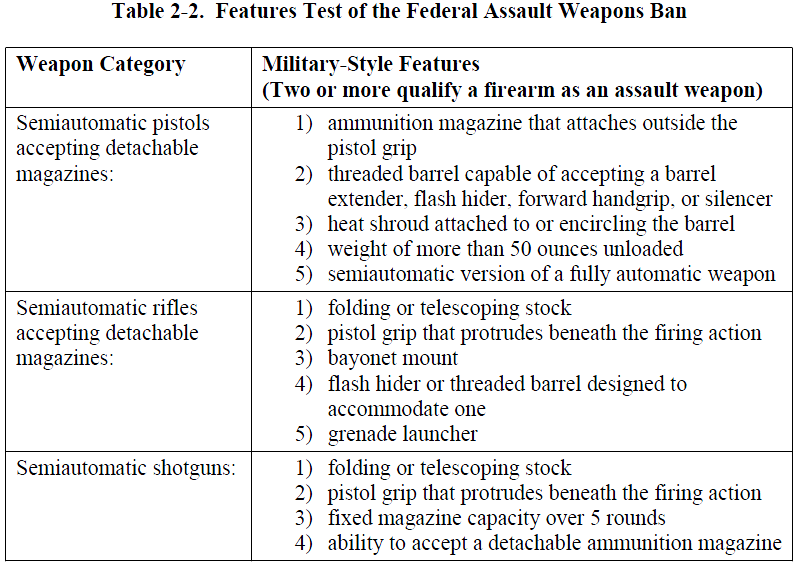Gun Control & RKBA
Related: About this forumAn Updated Assessment of the Federal Assault Weapons Ban: Impacts on Gun Markets and Gun Violence
An Updated Assessment of the Federal Assault Weapons Ban: Impacts on Gun Markets and Gun Violence, 1994-2003
Christopher S. Koper, Daniel J. Woods and Jeffrey A. Roth
114 pages
June 2004
The Ban’s Success in Reducing Criminal Use of the Banned Guns and Magazines Has Been Mixed
• Following implementation of the ban, the share of gun crimes involving AWs declined by 17% to 72% across the localities examined for this study (Baltimore, Miami, Milwaukee, Boston, St. Louis, and Anchorage), based on data covering all or portions of the 1995-2003 post-ban period. This is consistent with patterns found in national data on guns recovered by police and reported to ATF.
• The decline in the use of AWs has been due primarily to a reduction in the use of assault pistols (APs), which are used in crime more commonly than assault rifles (ARs). There has not been a clear decline in the use of ARs, though assessments are complicated by the rarity of crimes with these weapons and by substitution of post-ban rifles that are very similar to the banned AR models.
• However, the decline in AW use was offset throughout at least the late 1990s by steady or rising use of other guns equipped with LCMs in jurisdictions studied (Baltimore, Milwaukee, Louisville, and Anchorage). The failure to reduce LCM use has likely been due to the immense stock of exempted pre-ban magazines, which has been enhanced by recent imports.
It is Premature to Make Definitive Assessments of the Ban’s Impact on Gun Crime
• Because the ban has not yet reduced the use of LCMs in crime, we cannot clearly credit the ban with any of the nation’s recent drop in gun violence. However, the ban’s exemption of millions of pre-ban AWs and LCMs ensured that the effects of the law would occur only gradually. Those effects are still unfolding and may not be fully felt for several years into the future, particularly if foreign, pre-ban LCMs continue to be imported into the U.S. in large numbers.
The Ban’s Reauthorization or Expiration Could Affect Gunshot Victimizations, But Predictions are Tenuous
• Should it be renewed, the ban’s effects on gun violence are likely to be small at best and perhaps too small for reliable measurement. AWs were rarely used in gun crimes even before the ban. LCMs are involved in a more substantial share of gun crimes, but it is not clear how often the outcomes of gun attacks depend on the ability of offenders to fire more than ten shots (the current magazine capacity limit) without reloading.
• Nonetheless, reducing criminal use of AWs and especially LCMs could have nontrivial effects on gunshot victimizations. The few available studies suggest that attacks with semiautomatics – including AWs and other semiautomatics equipped with LCMs – result in more shots fired, more persons hit, and more wounds inflicted per victim than do attacks with other firearms. Further, a study of handgun attacks in one city found that 3% of the gunfire incidents resulted in more than 10 shots fired, and those attacks produced almost 5% of the gunshot victims.
• Restricting the flow of LCMs into the country from abroad may be necessary to achieve desired effects from the ban, particularly in the near future. Whether mandating further design changes in the outward features of semiautomatic weapons (such as removing all military-style features) will produce measurable benefits beyond those of restricting ammunition capacity is unknown. Past experience also suggests that Congressional discussion of broadening the AW ban to new models or features would raise prices and production of the weapons under discussion.
• If the ban is lifted, gun and magazine manufacturers may reintroduce AW models and LCMs, perhaps in substantial numbers. In addition, pre-ban AWs may lose value and novelty, prompting some of their owners to sell them in undocumented secondhand markets where they can more easily reach high-risk users, such as criminals, terrorists, and other potential mass murderers. Any resulting increase in crimes with AWs and LCMs might increase gunshot victimizations for the reasons noted above, though this effect could be difficult to measure.

http://publicintelligence.net/nij-assault-weapons-ban-study/